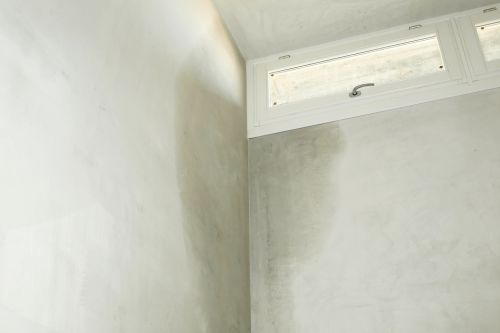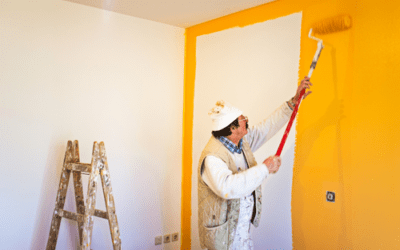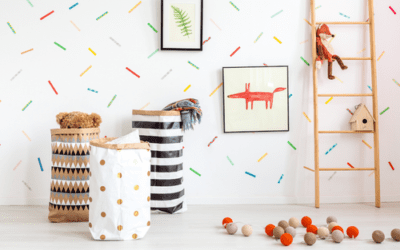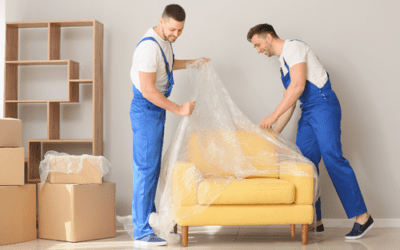Damp walls are a common problem in many homes, especially in areas with humid climates or in poorly ventilated dwellings. Moisture not only affects aesthetics, but can also damage the structure of the house and the health of its inhabitants. In this guide, we will explain how to choose the right paint for damp walls, the most effective options and how to apply it correctly.
Why does dampness on walls occur?
Dampness in walls can have various causes, such as water infiltration from outside, internal condensation, or waterproofing problems. Identifying the cause is crucial before proceeding with any treatment.
Water infiltration
Water infiltration is one of the main reasons for damp walls. It occurs when water penetrates from the outside due to problems in the façade or in the waterproofing of the walls. If you notice damp stains on the lower part of the walls, it is probably due to this problem. The best way to combat this is with a façade waterproofing treatment on the façade, accompanied by a paint suitable for damp environments.
Contact our professionals to paint the walls of your home
Condensation
Condensation occurs when warm, moist air inside the house comes into contact with cold surfaces, such as walls. This is common in bathrooms and kitchens, where a lot of steam is generated. The solution in these cases includes improving ventilation and applying a breathable paint that allows water to evaporate from the surface.
Types of paints for damp walls
There are several paint options specifically designed to treat walls affected by damp. Here are the most effective ones.
Damp-proof paints
Damp-proof paints are a common and effective solution for treating damp walls. These paints contain ingredients that prevent water from penetrating the walls, creating a protective barrier. In addition, some versions have fungicidal properties that prevent the formation of mould and mildew.
Advantages:
- They waterproof walls.
- They prevent the formation of mould and fungus.
- They are easy to apply.
Recommendation: At Bartolomé Bas Pinturas we use high quality damp-proof paints to ensure a long-lasting and effective finish. If you need more information, consult our exterior paint section.
Breathable Paints
This type of paint is ideal for places with condensation problems, as it allows the wall to “breathe”. This means that it allows water vapour to pass through, preventing it from accumulating and turning into droplets that wet the surface.
Advantages:
- They allow moisture to evaporate.
- They reduce condensation on surfaces.
- They are ideal for bathrooms and kitchens.
Recommendation: Opt for breathable paints if you live in an area with high ambient humidity or if condensation problems are frequent in your home. These products can be found in our interior paint solutions.
Anti-mould paints
Anti-mould paints contain additives that prevent the growth of mould and mildew on the wall surface. They are especially recommended for areas prone to moisture, such as basements, bathrooms and kitchens.
Advantages:
- They prevent the growth of mould and mildew.
- They provide a durable finish.
- They can be used in combination with other damp-proofing treatments.
Recommendation: At Bartolomé Bas Pinturas we recommend the use of anti-mould paints in combination with our damp removal techniques, to ensure a healthier and more aesthetically pleasing environment.
How to apply paint on damp walls
The correct application of paint is key to ensure that the solution is long-lasting and effective. Here are the essential steps for applying paint to damp walls.
Surface preparation
Before applying any type of paint, it is essential to prepare the surface properly. This includes removing existing mould, repairing cracks and making sure the wall is completely dry.
- Cleaning: Use a specific product to eliminate mould and fungus.
- Repair: Fill cracks and holes with a suitable filler.
- Drying: Make sure the wall is dry before painting. If necessary, use dehumidifiers or fans.
Primer application
A damp-proof primer or sealer is essential to ensure paint adhesion and provide an additional layer of protection against moisture. Apply an even coat and allow to dry according to the manufacturer’s instructions.
Final painting
Once the primer is dry, you can proceed to apply the chosen damp-proofing, breathable or mildew-proofing paint. Apply at least two coats to ensure complete and durable coverage.
Long-term maintenance and prevention
After painting, it is important to maintain the right conditions to prevent moisture from returning. Here are some useful tips.
Improve ventilation
Maintain good ventilation throughout the house, especially in moisture-prone areas such as bathrooms and kitchens. This helps to reduce condensation and keep walls dry.
Check sources of moisture
Regularly inspect the outside of your home to make sure there are no water leaks. Check gutters, roof and exterior walls for possible waterproofing problems.
Paint maintenance
Over time, paint can wear off, especially in areas with high humidity. Perform regular maintenance, touching up or repainting as necessary, to maintain the protection of the walls.
Other publications that may interest you
Why hire a professional painter to paint your house?
Hiring a professional painter to paint your house may seem like an unnecessary expense. However, there are several reasons why it is a good idea to invest in the services of an experienced painter in this coastal area of Alicante. Firstly, a professional will have...
The importance of the choice of colour in a child’s room
The choice of colour in the children's room is an important factor to consider. Colour can affect children's mood, behaviour and health. Therefore, it is essential to choose colours that are attractive to children, but also safe and healthy for them. When it comes to...
Covering floors and furniture with tarpaulins before painting the house
If the time has come to whitewash the walls of your house, you will most likely have to start by covering the floors and some furniture with tarpaulins. You cannot skip this step for any reason, otherwise you will find yourself scraping the floor and trying (in vain)...




